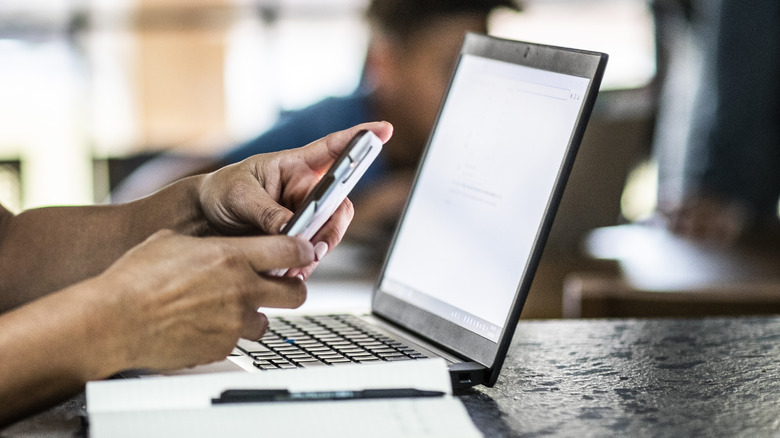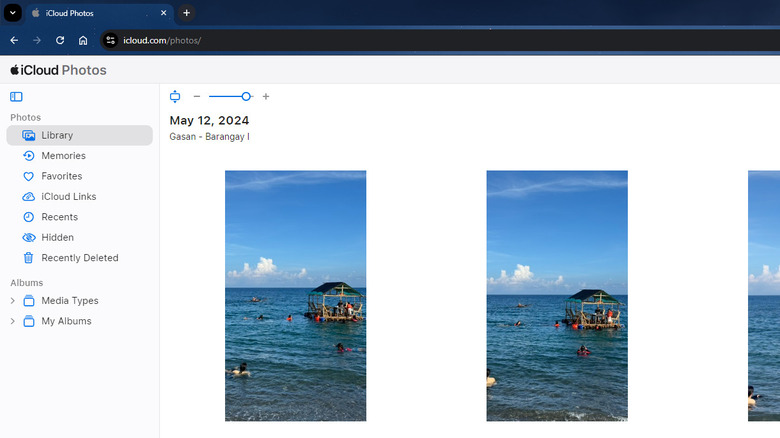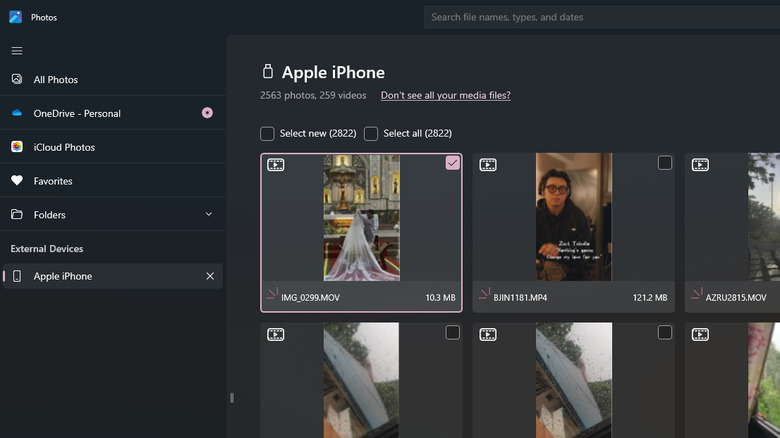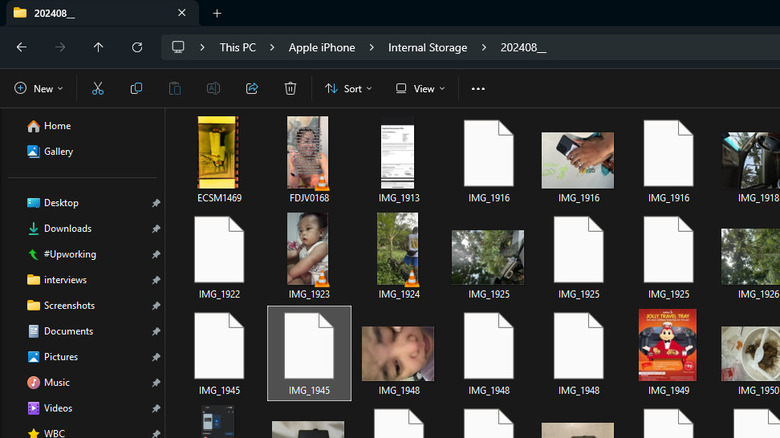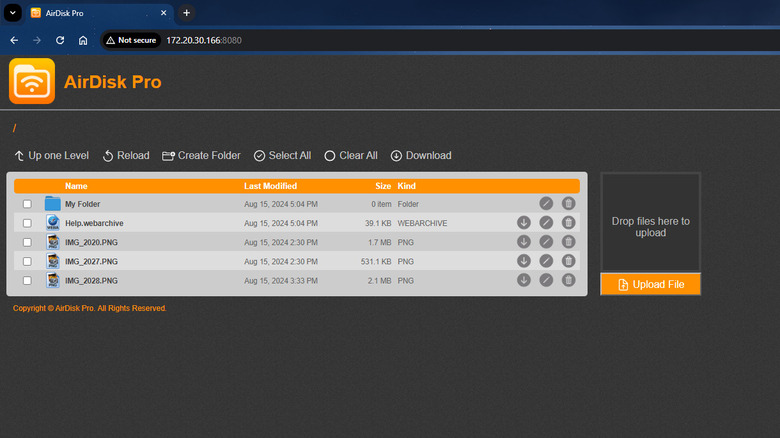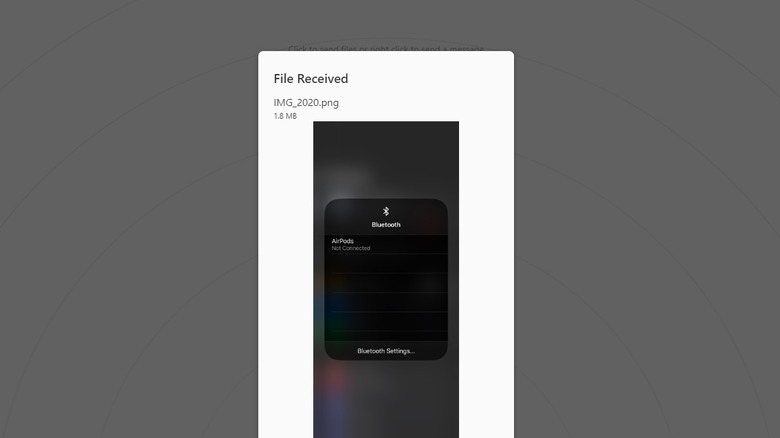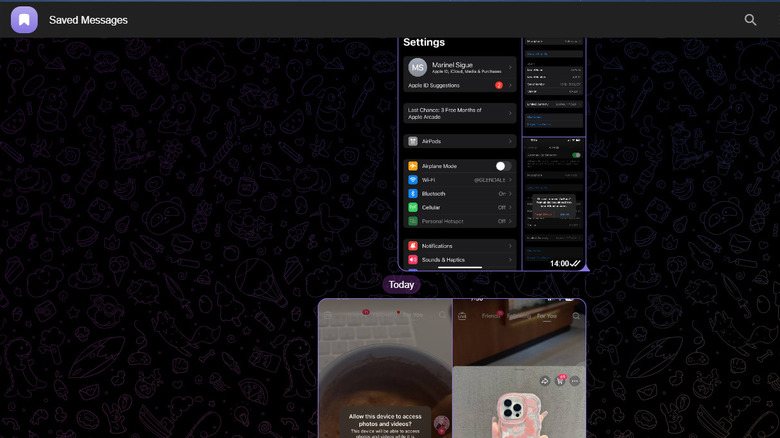How To Transfer Photos From iPhone To PC
With iPhone photography on the rise, chances are you're one of many who has a bajillion pictures on their iPhone. In an ideal world, these photos would stay on your device forever, but unfortunately, your iPhone can only store so much. Once your storage space runs out, you'd eventually have to move your images elsewhere. Sure, your iCloud is among the top candidates for such a task. However, if it's important to you that you can easily access your files offline, then keeping them in the cloud isn't the best solution. Instead, what you need is a local storage unit like your Windows computer.
The caveat of this alternative, however, is the transfer process. Unlike Android phones where you can simply open the Bluetooth and start sending photos to your PC, iPhones are much more restrictive in that regard. Their Bluetooth is only designed for connecting to devices, not sharing files. That's why you need to find other methods to transfer your iPhone images to your PC. We'll show you six quick and easy ways to go about this.
Method 1: Access the images on iCloud Photos on your PC's browser
iCloud Photos conveniently syncs with your iPhone's Photos app, automatically uploading your pictures and videos directly to your iCloud account. These media retain their full resolution and HEIF/HEVC format, so you won't have to worry about losing the original image quality (you do have to consider your iCloud storage and make sure it's large enough to accommodate your media). Since your iCloud is accessible from any browser on any device, it's one of the easiest ways to wirelessly transfer photos from your iPhone to PC. Here's how to set up and access iCloud Photos:
- On your iPhone, launch the Settings app.
- Tap your name at the very top of the page.
- Navigate to iCloud > Photos.
- Turn on Sync this iPhone if it isn't already enabled.
- Open your favorite browser on your PC.
- Sign in to icloud.com using the same Apple ID used in your iPhone.
- When prompted, press "Allow" on your iPhone and enter the six-digit code generated to proceed with the sign-in process.
- (Optional) Press "Trust" to trust your browser and avoid being asked for a verification code next time.
- On your iCloud homepage, click on the Photos section.
- Scroll through the library to find the photo you need.
- Double-click on the image to open it.
- Select the download icon in the upper-right corner to download the picture.
- To download multiple images at once, press and hold the Ctrl key and select the pictures you want to download. Then, hit the download button at the top. They will be compiled into a ZIP file that you'll need to extract.
You should be able to see your iPhone photos in your PC's Downloads folder afterward.
Method 2: Import your iPhone photos to the Windows Photos app
If you're transferring a bulk of your photos to your PC and find downloading from iCloud too cumbersome, Windows offers a neat alternative: its Photos app. One of Photos' cool features is importing images and videos from connected USB devices like your iPhone, making transferring photos a breeze. Follow these steps to use it:
- Connect your iPhone to your computer via a USB data cable.
- Navigate to This PC to check whether your device has been read. If you can't find your iPhone under the list of USB devices, try unlocking it first.
- Launch the Photos app on your Windows.
- Press "Import" in the top right of the screen. You should see the Apple iPhone option appear.
- Click on Apple iPhone.
- If you get a "We couldn't reach your device" notification, open your iPhone. Then, tap on "Allow." Back on the notification on your computer, hit "Retry." All the photos and videos stored locally on your iPhone (not iCloud!) will now be imported to the Windows Photos app. This might take a while depending on how many images you have on your mobile device.
- Mark the checkbox in each image's top-right corner to select it. Or, if you want to select all the media, click "Select all" at the top.
- After choosing all the iPhone photos you want to transfer to your PC, click Add items.
- Select which existing folder you want to save the images to. Alternatively, press "Create folder" to make a new one. Take note of the directory displayed at the top, as this will be where you'll find your photos later.
- Hit "Import."
- Verify that the pictures have been saved by opening the folder you chose earlier.
Once the transfer is done, you can proceed with disconnecting your iPhone from your PC.
Method 3: Grab the photos from Windows File Explorer
When you connect your iPhone to your PC via a data cable, the images and videos saved locally on your device become immediately accessible to your computer. This means you can view and save them to your PC by just using the File Explorer, and compared to the Windows Photos import method, you won't have to wait as long for all your iPhone media to load. Here's a step-by-step guide on how to transfer your iPhone pictures to PC via the File Explorer:
- Use a compatible USB data cable to connect your iPhone and PC.
- When prompted on your iPhone, press "Trust" to give your computer access to your data.
- Open your Windows File Explorer if it hasn't automatically launched yet.
- Go to This PC.
- Open Apple iPhone.
- Click on Internal Storage to see the local media on your iPhone.
- Find the image you want to transfer to your PC. Each of the folders you'll see here corresponds to the year and month the media were taken. So if you're after a photo you just snapped a couple of seconds ago, look for the folder of the current year and month.
- (Optional) Change the view size to make browsing the photos easier. Press "View" at the top and select "Extra large icons" to enlarge the photo previews.
- Select all the images you need to transfer.
- Drag and drop them to your Desktop, found on the left side panel. Your photos should then be copied automatically to your Desktop folder, where you can now view them.
If you want to change the format of your photos from HEIC to JPG or PNG before transferring, double-click on the image and press Ctrl + S to save it. Then, in the "Save as type" field, choose your preferred file format.
Method 4: Use a wireless flash drive app
Admit it — scouring your drawers for a USB data cable is always such a hassle. Your cables seem to go missing every time you need them. If you prefer going the wireless route of transferring your iPhone photos to your PC, then using a wireless flash drive app like AirDisk might just be the method for you. Follow these easy steps to use AirDisk:
- Install AirDisk on your iPhone.
- Open the app.
- Keep pressing "Next" on the welcome pages.
- Once you get to the home page, tap on the plus icon in the middle.
- Choose Library.
- Tap on "Allow Full Access" to grant AirDisk permission to access your photos and videos.
- Select the photos you need to transfer.
- Press "Import" in the upper-right corner to import the pictures to AirDisk.
- Select the "Sync" button in the bottom-right corner.
- Under File Transfer, choose Wi-Fi File Transfer. This will display an IP address where you can access the photos you imported.
- On your computer, connect to the same Wi-Fi network your iPhone uses.
- Open your browser.
- Type the IP address generated in AirDisk.
- To save the images to your computer, mark all the images you want and hit the Download button at the top.
Afterward, navigate to your PC's Downloads folder and find the ZIP file. Extract the contents to view your images. AirDisk also works the other way around. From AirDisk on your computer's browser, you can send files to your iPhone. Simply drag and drop the file to your browser to automatically upload them. They will then be available on your iPhone's AirDisk. However, it's important to note that once you close the Wi-Fi Transfer dialog on your iPhone, the connection will also be cut off.
Method 5: Transfer photos wirelessly with Snapdrop
You probably aren't a fan of installing transfer apps on your iPhone, and honestly, they aren't really worth it if you're only going to use them once every six or so months. So, now what do you do when you need to transfer your iPhone photos over to your PC but don't have a transfer app and a USB cable and don't use iCloud for your pictures? The answer is Snapdrop. This free file transfer service lives only on your browser, requiring no installation on both your iPhone and PC. To transfer images from iPhone to PC with Snapdrop, follow these steps:
- Connect your iPhone and computer to the same Wi-Fi network.
- Visit snapdrop.net on both your devices.
- Take note of the randomly generated username for your iPhone and PC. This is found on the bottom of the page.
- On your iPhone:
- Tap on your PC's name that appears on your Snapdrop page.
- Select Photo Library from the menu.
- Pick the images you'll be sending to your computer.
- After choosing your photos, press "Add" in the upper-right corner. Your file will then be automatically transferred to your computer, and you'll see a "File transfer completed" message momentarily at the bottom of the screen once the transfer is done.
- On your PC:
- Click on "Save" on the File Received notification that pops up on your Snapdrop page.
- Uncheck the "Ask to save each file before downloading" if you want to automatically save the photos as soon as you receive them.
- When prompted, select "Allow" in the "Download multiple files" notification.
When you open the Downloads folder on the PC, each of the photos you sent from your iPhone will be saved here individually.
Method 6: Go the good old messaging route
Another ever-reliable way of transferring images from your iPhone to PC without needing USB cables is via messaging apps. This is probably one of the most frequently used methods, as most people already rely on messaging apps in their day-to-day routine. If you prefer this approach for sending your images to your PC, Telegram is a great option. It's a nifty alternative to Meta's Messenger app, and it allows sending files as large as 2 GB. Here's how to use Telegram for transferring your iPhone images to PC:
- Install Telegram on your iPhone if you haven't already.
- Log in or create an account.
- Tap on the "Settings" tab.
- Select Saved Messages. This will open a private conversation thread that only you have access to.
- Press the attach icon in the bottom-left corner.
- Mark the images you wish to send to your PC. You can choose to send up to 100 photos at once.
- (Optional) Type a caption in the empty field to provide more context about the images.
- Press "Send" once done.
- Open a browser on your PC.
- Go to web.telegram.org.
- Press "Log In By Phone Number."
- Sign in to your account.
- Open Saved Messages from your conversation list.
- Click on the sent image to open it.
- Hit the download icon at the top to save the photo to your local PC storage.
Unfortunately, Telegram doesn't offer a bulk download option. If you're dealing with several images, you'd need to save them to your PC one by one.
